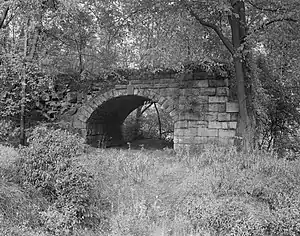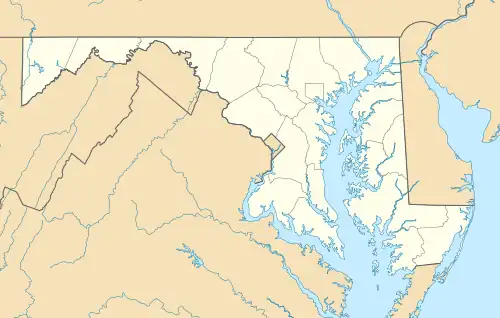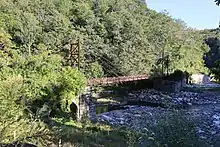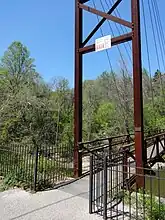Patterson Viaduct | |
|---|---|
 Patterson Viaduct Ruins, 1970 | |
| Coordinates | 39°14′56″N 76°45′53″W / 39.248889°N 76.764722°W |
Patterson Viaduct Ruins | |
  | |
| Nearest city | Ilchester, Maryland |
| Area | 2 acres (0.81 ha) |
| Built | 1829 |
| Built by | Wever, Caspar; McCartney, John |
| Architectural style | Masonry Arch Bridge |
| NRHP reference No. | 76002221[1] |
| Added to NRHP | June 3, 1976 |
| Crosses | Patapsco River (before 1868) |
| Locale | Ilchester, Maryland |
| Official name | Patterson Viaduct |
| Characteristics | |
| Design | Arch bridge |
| Total length | 360 feet (110 m) |
| Longest span | 55 feet (17 m) |
| Clearance below | 43 feet (13 m) |
| History | |
| Opened | December 1829 |
| Closed | 1868 |
| Location | |
The Patterson Viaduct was built by the Baltimore and Ohio Railroad (B&O) as part of its Old Main Line during May to December 1829. The viaduct spanned the Patapsco River at Ilchester, Maryland. It was heavily damaged by a flood in 1868 and subsequently replaced with other structures.[2]
History and design
Original bridge
The Patterson Viaduct was one of three (along with the Carrollton Viaduct and Oliver Viaduct) constructed for the first phase of the railroad, which ran 13 miles (21 km) between Baltimore and Ellicott's Mills (today's Ellicott City). Similar in construction to the Carrollton Viaduct, the Patterson Viaduct was named for B&O director and well known civic leader and merchant William Patterson, who also donated land for Patterson Park in east Baltimore. It was designed by Caspar Wever and built under the supervision of John McCartney, one of Wever's assistants. McCartney's good work on the Patterson Viaduct was later rewarded with the contract to build the longer curving Thomas Viaduct downstream over the Patapsco at Relay in 1833–1835.
Constructed of granite blocks, the viaduct was about 360 feet (110 m) long, rising about 43 ft (13 m) above its foundations. It had four graduated arches: two of 55 ft (17 m) chord length each and two of 20 ft (6.1 m) chord length each. The two smaller side arches allowed the passage of two county roadways, one on each side of the river. The exterior surfaces of the granite blocks were rusticated.
Patterson ceremonially opened the viaduct on December 4, 1829, a year and a half after construction began on the line, the first in America.[3] In 1830, the viaduct was part of the route used by the B&O's first horse-drawn carriage train to Ellicott's Mills inaugurating railway traffic.[4]
Second bridge
The viaduct was almost totally destroyed in 1868 by a massive flood that devastated and wiped out numerous stone mills and industrial structures along the river. In 1869, it was replaced by a single-span Bollman truss of cast and wrought iron by Wendel Bollman, reusing the original roadway arch and upstream wing wall of the west abutment.
In 1903, the Bollman truss was supplanted when the track was moved to a new bridge and alignment about 400 ft (120 m) upstream with the opening of the Ilchester Tunnel.
Third bridge


Today, all that remains of the original 1829 viaduct is the single arch that spanned the roadway on the west bank and the abutment on the east bank. The ruins were listed on the National Register of Historic Places on June 3, 1976. In 2006, a cable-stayed footbridge carrying the Grist Mill Trail, with a design that echoes the historic architecture and engineering of a Bollman Bridge, was added atop the abutments.
See also
- List of Howard County properties in the Maryland Historical Trust
- List of bridges documented by the Historic American Engineering Record in Maryland
- List of tunnels documented by the Historic American Engineering Record in Maryland
- List of bridges on the National Register of Historic Places in Maryland
References
- ↑ "National Register Information System". National Register of Historic Places. National Park Service. July 9, 2010.
- ↑ Pamela James (August 1975). "National Register of Historic Places Registration: Patterson Viaduct" (PDF). Maryland Historical Trust. Retrieved 2016-01-01.
- ↑ Laura Rice. Maryland History In Prints 1743-1900. p. 80.
- ↑ Amy Worden (10 December 1987). "A Bridge to Howard County's Past; Railroad History Buffs Urge Preservation of 157-Year-Old Landmark on Patapsco River". The Washington Post.
External links
- Maryland Historical Trust, Crownsville, MD. "Patterson Viaduct Ruins." Accessed 2016-01-22.
- Historic American Engineering Record (HAER) No. MD-12, "Baltimore & Ohio Railroad, Patterson Viaduct, West Bank of Patapsco River, near Ilchester Bridge, Ilchester, Howard County, MD", 1 photo, 1 photo caption page
- HAER No. MD-21, "Baltimore & Ohio Railroad, Ilchester Tunnel, East side of Patapsco River, Ilchester, Howard County, MD", 1 photo, 1 photo caption page

